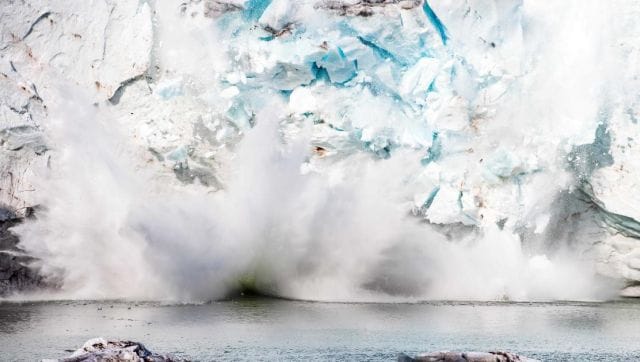It’s getting hot, hot, and hot and our world is likely to break a key temperature limit for the first time over the next few years, scientists predict. On Wednesday, the World Meteorological Organisation (WMO) said there was a 66 per cent chance that global temperatures in at least one of the years between 2023 and 2027 would exceed the pre-industrial average by 1.5 degrees Celsius or more. It further reported that as it becomes hotter, there’s a 98 per cent chance that at least one of the next five years would be the warmest year on record, breaking the record of 2016. Prof Petteri Taalas, the secretary general of the WMO, said: “This report does not mean that we will permanently exceed the 1.5 degrees Celsius specified in the Paris agreement, which refers to long-term warming over many years. However, WMO is sounding the alarm that we will breach the 1.5 degrees Celsius level on a temporary basis with increasing frequency.” Scientists have said that breaching this limit even for a year is a clear indicator that warming is accelerating and not slowing down. In its report, the WMO attributes the rise in temperatures to the burning of fossil fuels as well as the arrival of El Nino – a natural climate phenomenon with a global heating effect. “A warming El Niño is expected to develop in the coming months and this will combine with human-induced climate change to push global temperatures into uncharted territory,” Taalas said. “This will have far-reaching repercussions for health, food security, water management and the environment. We need to be prepared.” As the world braces for this climate milestone, here’s a better understanding of what is the 1.5 degrees Celsius limit that the WMO is speaking of? And why is it crucial? What is this 1.5 degree Celsius limit? The need to limit global warming to
1.5 degrees Celsius is always emphasised in climate reports and summits. The 2015 Paris Agreement, a legally binding international treaty on climate change, commits countries to limit the global average temperature rise to well below 2°C above pre-industrial levels, and to aim for 1.5°C. Climate leaders and scientists have warned that crossing the 1.5°C threshold risks unleashing far more severe climate change effects on people, wildlife, and ecosystems. Warning that the world is on a “fast track” to disaster, UN Secretary-General António Guterres said, “It is time to stop burning our planet…” What is the earth’s temperature now? Earth’s global surface temperature has increased by around 1.1°C compared with the average compared between 1850 and 1900. Each of the last four decades has been hotter than any decade since 1850. Such a rise in temperatures hasn’t been witnessed since 125,000 years ago, before the most recent ice age. [caption id=“attachment_12612252” align=“alignnone” width=“640”] A southeast Greenland polar bear on glacier, or freshwater, ice is seen. According to scientists, breaching the climate limit is a clear indicator that warming is accelerating and not slowing down. File image/Reuters[/caption] How will the 1.5 degrees Celsius be measured? The declaration that Earth has reached 1.5℃ warming since the pre-industrial era will not be made after a single year, or a single location, passes that threshold, reports The Conversation. The warming is measured as a global average over 20 years, to account for natural variability in the system. Before global average temperatures officially reach 1.5℃ warming, we can expect quite a few years will exceed that limit. Global temperatures exceeded 1.5℃ warming during individual months at the peak of the 2015-16 El Niño, the report says. What happens if the hotting up continues? Climate change is affecting every part of the globe. “For every increment of global warming, changes in extremes become larger,” climate scientist Sonia Seneviratne at ETH Zurich told Reuters in 2021. Heatwaves become more severe, as we are already witnessing across
India , and they are now occurring in areas where they did not before. A study published by scientists at the Banaras Hindu University’s Mahamana Centre of Excellence in Climate Change Research found that heatwave patterns in India have shifted, with a significant increase in heat waves in north-western, central, and south-central India. The country witnessed the hottest March in the last 122 years in 2022. [caption id=“attachment_10519431” align=“alignnone” width=“640”]
 Heatwaves are becoming more severe, as we are already witnessing across India. AFP[/caption] An extreme heat event that occurred once per decade in a climate without human influence, would happen 4.1 times a decade at 1.5°C of warming, according to the Intergovernmental Panel on Climate Change (IPCC). A warmer atmosphere holds more moisture and this results in extreme rainfall, increasing the risks of floods. It also increases evaporation, leading to more intense droughts. In 2021, torrential rains flooded China and Western Europe, killing hundreds. Hundreds more died when temperatures in the Pacific Northwest hit record highs. Greenland saw massive melting events, wildfires ravaged the Mediterranean and Siberia, and a record drought affected parts of Brazil, Reuters reported. Can we keep the 1.5 degrees Celsius target? While some climate experts are positive, others believe that the target is slipping out of reach faster than we can imagine. “Is it still possible to limit global warming to 1.5 °C? The answer is yes,” Maisa Rojas, Chile’s environment minister and a lead author of the IPCC report, said last August. “But unless there are immediate, rapid, and large-scale reductions of all greenhouse gases, limiting global warming to 1.5 °C will be beyond reach.” After the first part of the IPCC report was released last year, teenage climate activist Greta Thunberg has said that at the current emission rate, the 1.5 degrees Celsius target will be exceeded by 2026. What needs to be done to meet the goal? In order to achieve the 1.5 degrees Celsius target, the world must reduce annual carbon dioxide emissions by 48 per cent by 2030, and reach net zero by 2050, while reducing methane emissions by a third by 2030 and almost halving them by 2050. Global greenhouse emissions needed to peak by 2025 “at the latest” if the world wanted to restrict temperature rise to within 1.5 degree Celsius from pre-industrial times. “The last two decades saw the highest increase in emissions in human history. Even though we know how much trouble we are in, the next decade cannot follow the same pattern if we are to hold the warming to 1.5 degrees Celsius. Half measures will not half greenhouse gas emissions by 2030. IPCC tells us that we have the knowledge and the technology to get this done,” said Inger Anderson, executive director, United Nations Environment Programme. Joyashree Roy, one of the coordinating authors of the report, said an important takeaway from the report is that the next few years will be critical when countries will decide on mitigating actions. “Unless mitigation action is taken, 1.5 degrees limit cannot be reached. We need to ramp up action without delay. The report says there are ways to improve our chances of success to limit global warming to 1.5 degrees Celsius,” Roy said while talking to the media. “Limiting global warming will require major transitions in the energy sector. This will involve a substantial reduction in fossil fuel use, widespread electrification, improved energy efficiency, and use of alternative fuels (such as hydrogen),” the report said. [caption id=“attachment_10519451” align=“alignnone” width=“640”]
 Each of the last four decades has been hotter than any decade since 1850. AFP[/caption] What is being done so far? “We are at crossroads. The decisions we make now can secure a liveable future. We have the tools and know-how required to limit warming,” said IPCC Chair Hoesung Lee. “I am encouraged by climate action being taken in many countries. There are policies, regulations, and market instruments that are proving effective. If these are scaled up and applied more widely and equitably, they can support deep emissions reductions and stimulate innovation,” Lee said on Monday. The United States, European Union, and the United Kingdom are leading the race to cut emissions targets among the world’s biggest economies. The UK has committed to cutting emissions at a faster rate than other developed nations, with a target of 68 per cent cuts by 2030. What about India? India is the third-largest emitter of carbon dioxide (CO2) after China and the US. Prime Minister Narendra Modi has set a target of net-zero greenhouse gas emissions by 2070. The country has also pledged that it will increase its non-fossil fuel energy capacity to 500 gigawatts (GW) by 2030. It currently has a capacity of around 157GW. With inputs from agencies Read all the Latest News , Trending News , Cricket News , Bollywood News , India News and Entertainment News here. Follow us on
Facebook,
Twitter and
Instagram.
In a new report, the World Meteorological Organisation said there was a 66 per cent chance that global temperatures would breach the crucial 1.5 degrees Celsius-mark in the next five years. El Nino and human activities are the likely reasons for pushing the mercury levels into ‘uncharted territory’
Advertisement
End of Article


)

)
)
)
)
)
)
)
)



